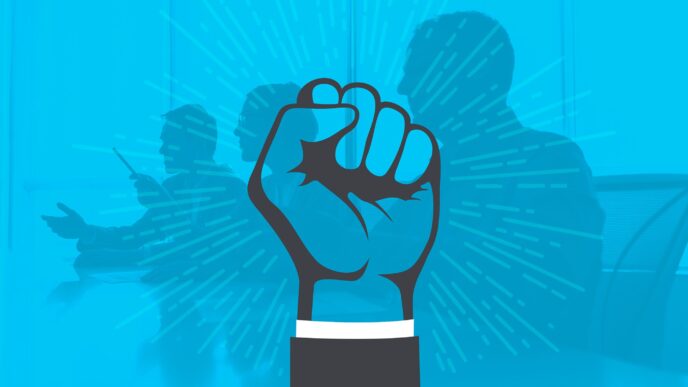In today’s volatile business environment, even the most established organisations can find themselves facing sudden and dramatic upheavals – whether in the form of economic crises, technological disruptions, or internal culture clashes. The rising complexity and interdependence of global markets mean that events on one side of the world can rapidly reverberate across industries. In such climates, stability can feel elusive, and leadership becomes a pivotal factor in determining whether an organisation endures or collapses under mounting pressures.
When uncertainty looms, employees and stakeholders alike look to leaders for guidance, assurance, and a sense of direction. Leaders who can remain calm under pressure – while making swift, informed decisions – instil confidence and cohesion throughout their teams. Their ability to communicate honestly, adapt strategies on the fly, and rally people around a common purpose can mean the difference between floundering in adversity or transforming challenges into opportunities for growth. Resilient leadership, therefore, is not simply a ‘nice-to-have’ attribute; it is essential to maintaining business continuity and shaping a robust future.
The Nature of Crisis and Uncertainty
Crises and uncertainty are almost inevitable in today’s interconnected marketplace, where sudden shifts in consumer demand, regulatory mandates, or geopolitical events can throw even the best-laid plans into disarray. Recognising the nature and potential scope of these disruptions is the first step in developing a leadership style that can handle – and even capitalise on – turbulent circumstances.
Organisations may confront crises originating from various sources. Externally, a global economic downturn, a competitor’s disruptive technology, or public health emergencies can all create ripple effects across markets. Internally, issues such as flawed governance structures, leadership voids, or cultural misalignments can generate equally destabilising challenges. In many cases, external and internal triggers converge – causing financial strain, reputational setbacks, or operational breakdowns that require swift intervention.
Uncertainty has a direct effect on employee morale and decision-making. Workers, unsure of how upcoming changes will affect their roles, may experience heightened anxiety and disengagement. Productivity can suffer, and interpersonal conflicts may surface as departments compete for limited resources. Externally, customers and investors may question an organisation’s stability and credibility, leading to eroded trust or lost market share. Swift, empathetic communication becomes paramount in quelling fears and maintaining stakeholder confidence.
During uncertain times, the actions and demeanour of leaders often serve as a bellwether for the rest of the organisation. Leaders who respond with clarity, authenticity, and strategic vision can inspire others to remain focused, cohesive, and solution-oriented – even in the face of daunting challenges. Conversely, disorganised or inconsistent leadership can exacerbate turmoil, creating a vacuum of guidance when employees need it most. Ultimately, it is the leader’s capacity to balance decisive action with thoughtful consideration that sets the tone for how effectively – or ineffectively – an organisation weathers the storm.
Foundations of Steady Leadership
Leadership in turbulent times demands more than just strategic acumen. It calls for leaders who recognise their own limitations, acknowledge the emotional undertones of high-pressure situations, and adapt swiftly to unexpected changes. Three foundational elements – self-awareness and emotional intelligence, core values and principles, and an adaptive mindset – underpin the ability to maintain composure and guide organisations through challenging phases.
Self-Awareness and Emotional Intelligence
At its core, self-awareness involves understanding one’s own stress responses, communication style, and decision-making biases. Leaders who cultivate this sense of introspection can better manage their emotions, preventing fear or frustration from clouding judgement. Equally important is emotional intelligence, the ability to recognise and respond to the emotional states of others. When faced with uncertainty, teams often look to leaders for reassurance; a genuine, empathetic approach helps foster trust and unity.
- Identifying Personal Triggers: By recognising the conditions under which you’re most likely to lose composure – be it tight deadlines, unpredictable outcomes, or conflicting stakeholder demands – you can take proactive steps to minimise their impact.
- Demonstrating Empathy: Checking in with team members on both a personal and professional level can alleviate anxiety and cultivate a supportive environment. Small acts of empathy, such as acknowledging individual stressors or actively listening without judgement, can make a substantial difference to team morale.
Core Values and Principles
When caught in a vortex of shifting demands and conflicting information, leaders benefit from having a clear internal compass. Core values – such as integrity, fairness, and accountability – act as an anchor, providing clarity and consistency regardless of external pressures.
- Reinforcing Organisational Identity: Align decisions and communications with the organisation’s stated mission, reminding employees and stakeholders of the company’s overarching purpose. This consistency not only nurtures trust but also unites people around common goals, even as processes or strategies may pivot.
- Guiding Ethical Choices: In times of crisis, moral dilemmas often arise. A strong set of principles can direct leaders towards decisions that protect long-term reputations over short-term gains. Remaining transparent, even when sharing difficult truths, upholds credibility in the eyes of employees, customers, and regulators.
Adaptive Mindset
Steadiness under pressure doesn’t imply an unyielding adherence to a single course of action. On the contrary, it involves recognising when a pivot is necessary and having the courage to shift gears. An adaptive mindset encourages leaders to view challenges as catalysts for exploration and growth, rather than insurmountable roadblocks.
- Openness to Change: Embrace a learning-centred approach, where mistakes are seen as opportunities for improvement. Encouraging experimentation and recalibration, especially under tight timelines, can uncover innovative solutions that might remain hidden under more stable conditions.
- Continuous Learning: Seek out new information and perspectives – whether through data analysis, stakeholder feedback, or expert insights. By regularly updating your understanding of the market landscape, you can respond more effectively to unfolding events.
Combining these three foundations – emotional intelligence, guiding values, and an adaptive mindset – provides leaders with a solid base from which to navigate turbulence. These qualities not only support effective decision-making in times of crisis but also help cultivate an organisational culture that respects integrity, embraces change, and holds fast to shared purpose.
Tactic #1 – Decisive yet Informed Decision-Making
When organisations encounter turbulent conditions, the luxury of drawn-out deliberation often disappears. In such moments, leaders must strike a delicate balance between swift action and thorough information-gathering. While taking quick decisions can keep a crisis from escalating, acting without adequate data or the right counsel risks compounding the problem. The following strategies illustrate how leaders can remain both agile and precise when the stakes are high.
Balancing Speed and Accuracy
- Identify the Minimum Viable Information (MVI): Recognise that perfect information is rarely available during a crisis. Instead, pinpoint the core facts essential to making a well-founded decision. Apply a “need to know” filter to prioritise relevant data over peripheral details.
- Leverage Rapid Feedback Loops: Gather perspectives from diverse teams – such as operations, finance, or communications – to gain quick, yet comprehensive, insights. Update assumptions continually as fresh information surfaces, refining your decision-making approach in real time.
- Set Clear Decision-Making Protocols: Outline who has the final authority and on what basis decisions will be made. This clarity reduces confusion and ensures accountability when time is limited. Consider establishing emergency governance structures or cross-functional task forces to expedite approvals and implementation.
Empowering Teams to Act
- Delegate and Distribute Responsibility: One individual, however capable, cannot effectively process all streams of information in a crisis. By delegating tasks, leaders free themselves to focus on overarching strategy. Empower managers to make autonomous decisions within their areas of expertise, trusting them to provide regular status updates.
- Cross-Functional Collaboration: Encourage collaboration between departments that typically operate in silos. A combined effort accelerates problem-solving and broadens the pool of innovative ideas. Hold brief, focused huddles or virtual stand-up meetings to coordinate actions and maintain alignment among teams.
- Create a Culture of Trust: When employees understand that their input is both valued and expected, they are more likely to offer critical insights without hesitation. Recognise successes and encourage open communication – even if this means hearing uncomfortable truths.
Course Correction Under Pressure
- Monitor and Measure Outcomes: Define key performance indicators (KPIs) or quick metrics to track the effectiveness of each decision. Use dashboards or regular progress reports to stay informed, ensuring that the team can pivot if outcomes deviate from expectations.
- Embrace Iterative Adjustments: Be prepared to adjust course promptly when conditions change or if initial assumptions prove incorrect. This mindset minimises the sunk cost fallacy, where leaders cling to flawed plans. Demonstrate humility when revising decisions – admitting mistakes and adapting without delay builds credibility among stakeholders.
- Communicate Continuously: Maintain consistent channels for sharing updates with employees, partners, and customers. If a shift in direction is required, explain the rationale transparently so that the organisation understands why change is necessary.
At its core, decisive yet informed decision-making involves trusting your instincts while still leveraging the collective intelligence around you. Leaders who excel in this tactic show courage in acting quickly, clarity in defining responsibility, and humility in reassessing their plans. The result is a more agile, confident organisation – one that can not only respond to crises effectively but also discover new opportunities in the process.
Tactic #2 – Transparent and Empathetic Communication
In times of turmoil, stakeholders – employees, customers, and investors – look to leaders for clarity and reassurance. A lack of transparent communication fuels uncertainty, and an absence of empathy can erode trust even more quickly. Conversely, leaders who speak openly and from a place of genuine concern often find their teams uniting behind them, ready to follow their direction through the storm. Here are some practical ways to cultivate open, human-centric dialogue when it matters most.
Internal Communication: Calming the Waters from Within
- Honest Briefings: Share as much verified information as possible, even if the full picture is not yet clear. Explaining what is known – and what remains unknown – shows integrity and helps contain speculation. Frame updates in a straightforward manner, avoiding corporate jargon that might confuse or trivialise serious issues.
- Creating Safe Spaces for Dialogue: Host brief Q&A sessions or roundtable discussions to ensure employees can voice concerns and receive timely responses. Encourage questions, and be prepared to say, “I don’t know yet, but I’ll find out,” rather than offering ambiguous or misleading answers.
- Frequency and Consistency: Provide regular updates, whether the news is good or bad, so employees feel informed rather than left in the dark. Strive for consistency in tone and message. Hearing conflicting or sporadic accounts from leadership breeds anxiety and mistrust.
External Communication: Demonstrating Credibility and Compassion
- Transparent Stakeholder Engagement: Address customers, suppliers, and investors directly through open letters, social media posts, or special bulletins that give them clear and concise information. Acknowledge challenges candidly and outline the steps being taken to resolve them, offering specific timelines if possible.
- Proactive Media Relations: If the crisis has drawn public attention, consider designated spokespeople to manage interactions with journalists. Maintain a calm, fact-based approach in press engagements, emphasising empathy for those affected and a commitment to resolving underlying issues.
- Human-Centred Messaging: Focus on the impact decisions might have on people’s livelihoods, communities, or well-being, rather than purely financial metrics. Show genuine concern and avoid defensiveness, especially when faced with criticism – this fosters goodwill even under tense circumstances.
The Power of Empathy and Active Listening
- Acknowledging Emotions: Recognise that during uncertain times, employees may grapple with fears about job security, health, or career growth. Validating these feelings can alleviate anxiety. Similarly, external stakeholders may worry about product availability, contract stability, or returns on investment. Show that you understand these concerns before outlining your solutions.
- Tailoring Communication Styles: Different audiences – such as frontline employees, board members, and community partners – may require different levels of detail or different communication channels. Adapt your style: use succinct updates for broad audiences, and more nuanced discussions for specialised groups.
- Encouraging Feedback Loops: Make it clear that feedback – positive or negative – is welcomed. This openness can reveal blind spots in the organisation’s crisis response. Implement quick, simple ways for people to share input (e.g., online surveys, anonymous suggestions), and acknowledge contributions promptly.
Balancing Transparency with Strategic Confidentiality
Though transparency is crucial, there are moments when leaders must withhold certain details temporarily – such as sensitive legal or personnel matters. Maintaining a balance between honesty and discretion requires:
- Clarity about Boundaries: Communicate why some information cannot be disclosed yet, rather than leaving stakeholders to assume evasiveness.
- Ethical Framework: Ensure any confidentiality aligns with organisational values and legal obligations. Concealment driven purely by self-preservation can backfire if stakeholders later feel misled.
Ultimately, transparent and empathetic communication lays the foundation for trust – both internally and externally. In an environment fraught with uncertainty, honesty and concern signal that leaders value people over quick fixes or evasive tactics. By consistently displaying these qualities, leadership not only navigates immediate turbulence but also fortifies relationships that will serve the organisation well in calmer times and beyond.
Tactic #3 – Building Organisational Resilience
When confronted with unpredictable circumstances, an organisation’s capacity to withstand and adapt is often its most critical asset. Resilience isn’t about avoiding difficulties altogether; rather, it’s about developing structures, processes, and mindsets that enable a quick and effective recovery. A resilient organisation balances efficient operations with contingency planning, ensuring it can respond nimbly to sudden shifts without losing its core functionality or compromising long-term goals.
Scenario Planning and Risk Assessment
- Mapping Potential Vulnerabilities: Conduct regular reviews of operational workflows, supply chains, and external partnerships to identify possible points of failure. Use “what if” scenarios to explore how various disruptions might impact revenue streams, regulatory compliance, or public perception.
- Prioritising Risks: Not every conceivable disaster requires the same level of vigilance. Categorise risks based on likelihood and severity to allocate resources effectively. Establish thresholds for escalation: if certain trigger points are reached (e.g., a sudden drop in revenue or a key supplier shutdown), activate a predefined response plan.
- Embedding Continuous Monitoring: Install systems and processes that track critical indicators in near-real time. Train staff to interpret and act on these alerts swiftly, preventing minor hiccups from escalating into full-blown crises.
Flexibility in Structures and Processes
- Adaptive Operational Frameworks: Promote cross-training among teams so that employees can step into different roles if key personnel become unavailable. Diversify supplier relationships to reduce dependency on a single source. Having multiple backup options ensures minimal operational slowdown in case of disruptions.
- Agile Decision-Making: Break away from hierarchical bottlenecks by empowering middle managers to address urgent issues without waiting for top-level approval. Encourage iterative problem-solving, where small-scale experiments are launched quickly, results are measured, and successful approaches are scaled up.
- Building Safety Nets: Maintain reserve budgets or strategic alliances that can be tapped when unforeseen expenses or operational demands arise. Establish standby partnerships – such as temporary staffing agencies or collaborative networks – to help handle surges or specialised tasks in a crisis.
Continuous Learning and Skills Development
- Simulations and Drills: Conduct routine crisis-response exercises, where teams must act out potential disruptions (e.g., data breaches, media scandals). Use these simulations to evaluate the effectiveness of the organisation’s chain of command, resource allocation, and communication processes.
- Upskilling the Workforce: Offer training programmes that go beyond technical competencies, focusing on soft skills such as critical thinking, adaptability, and team leadership. Encourage employees to remain curious and engaged through learning platforms, mentorship schemes, and cross-departmental collaborations.
- Knowledge Sharing and Documentation: Maintain detailed records of past incidents and solutions – be they small setbacks or large-scale crises – to serve as a reference for future planning. Foster a culture where employees feel comfortable sharing insights, lessons, and best practices with one another.
Cultivating a Resilience Mindset
- Cultural Emphasis on Adaptation: Openly discuss resilience as a core organisational value, consistently highlighting examples of successful pivots or quick recoveries. Frame change as an opportunity for growth rather than a threat, thereby reducing resistance and anxiety.
- Celebrating Incremental Wins: Recognise individuals or teams that rapidly solve unexpected problems, reinforcing a collective sense of capability and preparedness. Communicate these success stories in company-wide meetings or newsletters to inspire others and reinforce resilience-building efforts.
- Leadership Sponsorship: Ensure top executives champion these principles, investing time and resources to align departmental goals with overarching resilience strategies. Visibility from the highest levels underscores the importance of resilience and signals that the organisation genuinely values agility over rigidity.
In essence, building organisational resilience is about preparing proactively rather than reacting hastily once a storm has arrived. By identifying risks, diversifying operational structures, and fostering a culture of continuous learning, leaders give their teams the tools to remain steady – even as circumstances shift with little warning. Over time, these efforts pay dividends not just in crisis scenarios, but also in day-to-day operations, where adaptability and efficiency become the cornerstones of competitive advantage.
Tactic #4 – Fostering a Unified Culture
In the midst of uncertainty, an aligned and cohesive organisational culture can act as a powerful bulwark against turbulence. When employees share common values, understand each other’s roles, and feel connected to a wider mission, they are more likely to stay motivated and collaborate effectively, even under immense pressure. This sense of unity not only sustains morale but also fuels resilience, creativity, and problem-solving on a company-wide scale.
Shared Purpose and Clear Mission
- Defining the “Why”: Articulate a clear organisational purpose that resonates with employees at all levels. When people grasp the larger goal behind their tasks, they can better contextualise their efforts in times of disruption. Reinforce this purpose regularly – through company-wide communications, internal newsletters, and team meetings – so it becomes a living, breathing part of daily operations.
- Goal Alignment: Ensure that department-level objectives trace back to overarching strategic goals. In a crisis, when priorities may shift rapidly, individuals and teams should still see how their actions contribute to the bigger picture. Host cross-departmental planning sessions or workshops to encourage shared ownership of both short-term deliverables and long-term vision.
Recognition and Support
- Investing in Well-Being: Pressure and anxiety often escalate during crises. Providing mental health resources, flexible working arrangements, or counselling services demonstrates genuine concern for employees’ welfare. Encourage managers to check in with their teams on a personal level – simple gestures of empathy can significantly boost morale.
- Open-Access Communication Channels: Create avenues for employees to voice concerns, ask questions, and offer feedback—whether it’s via dedicated digital forums or manager “office hours.” Acting on this feedback shows respect and strengthens employees’ sense of belonging.
Leading by Example
- Demonstrating Core Values: Leaders who embody the company’s principles – integrity, collaboration, empathy – set a powerful precedent. When employees witness authentic, value-driven leadership, they are more inclined to emulate these behaviours themselves, enhancing cultural cohesion.
- Consistency Under Pressure: Upholding principles during adversity signals that culture isn’t merely a public-relations slogan. For instance, if transparency is a core value, continue to share updates candidly, even if the news is difficult. Resist the temptation to deviate from established values for short-term gains – compromises at the top can fracture trust throughout the organisation.
Strengthening Community and Collaboration
- Team-Based Projects and Problem-Solving: Encourage employees from different functions to collaborate on crisis-related tasks or improvement initiatives. This cross-pollination of ideas sparks creativity and helps break down silos, reinforcing the concept of “one organisation, many perspectives.”
- Fostering Mutual Trust: Promote an environment where employees feel safe sharing bold ideas, even if they fail. Learning from setbacks together can strengthen bonds and accelerate collective problem-solving. Recognise collaborative efforts formally, giving credit not just to leaders but to the broader teams involved in delivering results.
Building and maintaining a unified culture is about more than uplifting morale – it’s about creating an environment where everyone feels invested in the organisation’s future, no matter the external or internal pressures. When a crisis hits, that shared sense of purpose and belonging becomes a vital source of energy and perseverance. By regularly reinforcing common values, recognising achievements, and upholding consistent leadership practices, organisations can cultivate the cultural fabric necessary for weathering storms and emerging stronger on the other side.
Tactic #5 – Maintaining Forward Momentum
Even in the throes of uncertainty, successful leaders keep one eye on the horizon. Maintaining forward momentum means recognising that crisis management is about more than just mitigating harm; it also involves identifying ways to evolve and seize opportunities that often emerge when conditions are turbulent. By deliberately looking beyond the immediate situation, leaders can guide their organisations to emerge not only intact but also more competitive and adaptive than before.
Identifying Growth Opportunities
- Scanning the Market: Conduct ongoing analyses of customer needs, competitive landscapes, and emerging technologies. Shifts in demand or unexplored niches may open a path to new revenue streams. Tap into frontline insights – customer service representatives, sales teams, and supply chain managers often spot early signs of market changes.
- Embracing Incremental Innovations: Encourage small-scale experiments that can be rapidly prototyped, tested, and refined. In uncertain times, smaller, iterative steps carry less risk but can still generate valuable breakthroughs. Recognise and reward teams that look for novel solutions to pressing problems, embedding an innovation mindset throughout the organisation.
- Strategic Partnerships: Explore alliances, joint ventures, or collaborations with companies that complement your strengths or open doors to new customer segments. Partnerships forged under pressure can yield lasting competitive advantages, provided both parties are aligned on objectives and values.
Innovation Under Pressure
- Reducing Red Tape: Temporarily streamline or suspend cumbersome approval processes that hinder creativity and rapid problem-solving. Foster cross-functional “innovation squads” tasked with tackling urgent challenges, giving them the autonomy to test solutions quickly.
- Repurposing Capabilities: In moments of disruption, established product lines or services might need to be adapted for new applications – consider how existing expertise or infrastructure can be redeployed to address emerging market needs. Use agile project management techniques to shift resources where they are most effective, minimising downtime and capitalising on shifting opportunities.
- Learning from Competitors and Peers: Monitor how others within your sector – or even adjacent industries – are adapting to similar challenges. Identify best practices or overlooked opportunities. Maintain informal networks of professional contacts to share insights and pool resources when facing common obstacles.
Sustaining Improvements Post-Crisis
- Documenting Lessons Learned: During the crisis, keep track of decisions, key metrics, and their outcomes. This data can reveal which quick fixes evolved into lasting best practices. Debrief project teams soon after crisis-related initiatives conclude, capturing insights while experiences remain fresh.
- Institutionalising Successful Changes: Determine which emergency measures should become permanent. For example, newly introduced communication channels or operational efficiencies might prove beneficial long term. Update manuals, training programmes, and standard operating procedures to embed these improvements into everyday organisational life.
- Building on the Momentum: Revisit strategic objectives in light of new market realities. If a recent pivot or innovation has proven fruitful, expand upon it systematically. Continue to set ambitious yet achievable targets, demonstrating confidence in the organisation’s potential to grow even under challenging circumstances.
Reinforcing a Growth Mindset
- Ongoing Skill Development: Provide training, workshops, or mentorship programmes that keep the workforce equipped for emerging roles and technologies. Support a culture where employees have the confidence to propose forward-looking ideas, knowing they will be heard and considered.
- Visionary Leadership: Executives should articulate a clear post-crisis vision, emphasising that the organisation is not only recovering but proactively shaping its future trajectory. Maintaining momentum requires continuous check-ins on progress, accountability from leaders, and recognition of the teams driving change.
Ultimately, maintaining forward momentum means transcending a purely defensive stance. By actively seeking new possibilities, encouraging iterative innovation, and integrating successful practices into the organisational framework, leaders transform uncertainty into an opportunity for advancement. In doing so, they ensure that once the immediate storm passes, the organisation stands ready to operate at a higher level of performance, innovation, and resilience than ever before.
Real-World Examples
While leadership strategies and resilience frameworks often sound theoretical, many organisations have successfully applied these principles to weather significant challenges – emerging not only intact but frequently stronger. Below are a few notable examples that illustrate how the tactics discussed in this article translate into real-world success.
Netflix’s Pivot from DVDs to Streaming
Background: Founded in 1997 as a mail-order DVD rental service, Netflix faced fierce competition from both traditional video stores and emerging digital platforms. Recognising the potential of online streaming, the company took a significant gamble by redirecting focus from DVDs to an all-digital subscription model.
Key Leadership Moves:
- Decisive Yet Informed Decision-Making: Netflix’s leadership conducted in-depth market analyses, identifying bandwidth improvements and changing consumer preferences as signals that streaming would soon dominate.
- Maintaining Forward Momentum: Even amid scepticism and customer backlash during its transition, Netflix persevered, using customer feedback to refine its offerings and pioneer original content production.
- Building Organisational Resilience: The shift required extensive internal reorganisation – engineering teams, content licensing, and marketing all had to adapt to a streaming-first world.
Outcome: Today, Netflix is a global leader in digital entertainment. Its bold pivot underlines the value of visionary leadership, willingness to adapt, and prioritising future opportunities even in the face of near-term uncertainties.
Airbnb’s Response to the COVID-19 Pandemic
Background: As global travel stalled due to COVID-19 restrictions in 2020, Airbnb lost a significant portion of its bookings almost overnight. The company faced layoffs, plummeting revenue, and deep uncertainty about the future of international travel.
Key Leadership Moves:
- Transparent and Empathetic Communication: Airbnb’s CEO, Brian Chesky, communicated openly about the company’s challenges and decisions – particularly staff layoffs – acknowledging the personal toll on employees.
- Innovation Under Pressure: The platform introduced “Online Experiences,” enabling hosts to offer virtual classes and workshops, thus diversifying Airbnb’s revenue and bringing a sense of connection to people stuck at home.
- Fostering a Unified Culture: Despite a difficult period, the company continued to emphasise core values, rallying employees around adapting their platform for safer and more flexible stays.
Outcome: By the time travel began to rebound, Airbnb had a leaner structure, a broader product offering, and a fortified brand reputation. The swift pivot to virtual experiences and transparent leadership style helped maintain trust among hosts, guests, and employees, ultimately positioning the company for a strong post-pandemic recovery.
Lego’s Turnaround from Near-Bankruptcy
Background: By the early 2000s, the Lego Group was on the brink of collapse due to over-diversification and declining sales of its core product, Lego bricks. The company needed a drastic strategy shift.
Key Leadership Moves:
- Decisive Focus on Core Strengths: Lego divested from peripheral ventures (theme parks, clothing lines) to refocus on its classic building-block sets, combining tradition with innovation such as Lego Mindstorms.
- Building Organisational Resilience: The leadership streamlined manufacturing processes, improved quality control, and forged strategic partnerships, including co-branded sets with popular film franchises.
- Fostering a Unified Culture: Internally, Lego re-emphasised creativity, play, and collaboration – values that resonated strongly with employees and customers alike.
Outcome: Lego’s dedication to its core product and its culture of innovation turned the company’s fortunes around. Today, it stands as one of the world’s most recognisable and beloved toy brands, demonstrating how realignment of mission and strategic pruning can restore organisational health.
Conclusion
Leading through tumultuous periods demands a careful blend of decisiveness, empathy, and strategic foresight. As we have explored in this article, crises rarely afford the luxury of measured deliberation – yet leaders who can navigate uncertainty with a calm, structured approach often emerge stronger than before. By applying the five core tactics detailed here – decisive yet informed decision-making, transparent and empathetic communication, building organisational resilience, fostering a unified culture, and maintaining forward momentum – leaders can effectively steer their teams through even the most daunting storms.
From creating robust contingency plans to nurturing a culture where every voice is heard, each tactic underscores a single overarching principle: crises are not solely threats to be survived, but also potential catalysts for growth. By focusing on open dialogue, shared values, and a willingness to pivot strategies swiftly, organisations can find opportunities hidden within adversity.
Ultimately, the key is to remain “steady under pressure” – to lead with courage and clarity while recognising that genuine resilience involves learning from missteps and continuously refining one’s approach. When crises strike, leaders who have cultivated adaptability, emotional intelligence, and trust will be best positioned to turn challenges into stepping stones, guiding their organisations not just towards recovery, but onto a path of long-term success.













